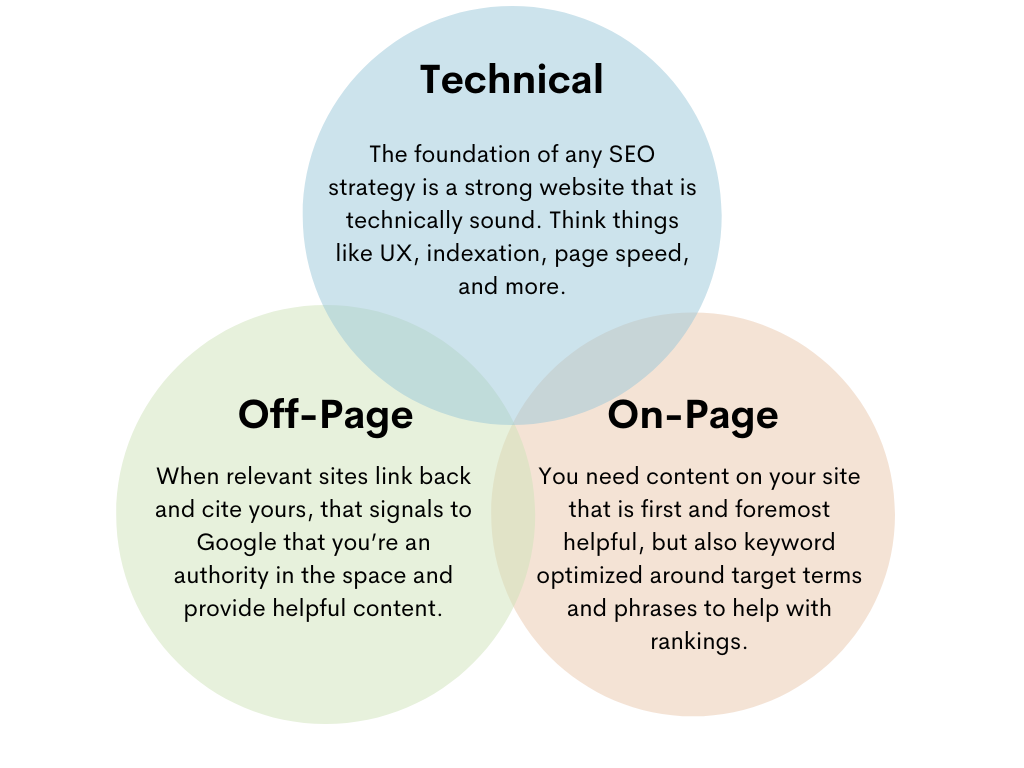The future is digital. These days, optimizing your digital content for search is crucial to position your marketing strategy for the future. Ready to incorporate search engine optimization into your marketing plan, but not sure where to start? Here are some search engine optimization techniques to try for yourself.
What are the three search engine optimization techniques?
The three main SEO techniques align with the three types of search engine marketing:
- Technical
- On-page
- Off-page

SEO is a broad field. A holistic SEO strategy divides different techniques into these three buckets for a well-rounded approach.
1. Technical audit
Technical SEO is the process of optimizing your website’s infrastructure for a better user experience and easy access by search engines. Evaluating and improving the technical side of your website is a crucial first step in search engine optimization. After all, if Google can’t understand your content, it can’t boost it to the top of the SERP.
To establish a strong technical foundation for your website, start by auditing the basics: website speed, structure, and mobile-friendliness.
Website speed is a critical metric for SEO. If your site loads slowly, users will not have a good experience with it – and won’t stick around. Google’s PageSpeed Insights tool is a fast and free way to check your speed. Its core vitals report is a great resource to take into a discussion about improvements with your website team.
A clear and simple site structure is invaluable. It improves your site experience for both people and search engines. Try to reduce your layers of navigation and use short, descriptive URLs.
Simplifying your site structure will also help with mobile-friendliness. A significant portion of your traffic is likely mobile, so a great mobile experience is essential to ranking in search results. Improving accessibility features like alt tags also boosts mobile-friendliness.
2. On-page content optimization
While all three types of SEO are crucial, content creation is the bread and butter of SEO. In many ways, your content drives the rest of your strategy.
Creating high-quality content that’s optimized to target keywords is called on-page SEO. It happens right there on your website. You have full control over these optimizations, which means it’s your opportunity to shine.
Before you create any content, you must have a keyword-driven content strategy. Without one, however, your content will be less focused and less likely to help you achieve your goals.
Firstly, start by identifying your content niche. Set out to solve your prospects’ problems – and not by recommending your own product. SEO content that’s truly helpful to readers will rise to the top of the SERP.
Once you’ve identified your niche, spend some time researching keywords to focus on. There are many keyword research tools available to help. You can also use customer and competitor research to learn what your audience is searching.
Finally, choose a keyword and create content with quality as your priority. What does “quality” mean to search engine algorithms? Google doesn’t share all its secrets, but we do have some guidelines. Google uses the E-E-A-T framework to help judge a piece of content’s quality.
- Expertise: The creator is an expert on the topic.
- Experience: They have firsthand experience with the topic.
- Authoritativeness: The creator and the hosting website show authority.
- Trustworthiness: The creator and website are reliable and credible.
One way to signal E-E-A-T factors to Google is to provide an author bio covering the creator’s credentials. Keeping your content easy to read, adding new insights to the topic, and using structural elements like headers also increase your chances of ranking.
Be sure to include your focus keyword in the body of your content as well as the title, URL, headers, meta description, and image tags.
3. Building backlinks
In addition to technical and content quality factors, there’s another element Google assesses when ranking your content: backlinks. Backlinks are links to your content from external sites.
Backlinks are important for the same reason people trust product reviews more than ads. Feedback from a third party is more likely to be trustworthy and accurate. Search engine algorithms assume that if lots of third parties link to your content, it must be helpful.
Once you’ve published your content, you can earn backlinks by targeting websites that appeal to your audience. Find existing content on the site where a link to your piece would fit. Then, reach out to the publication with a personalized message. Finally, give a summary of your content and how it helps their readers. Suggest the link’s location and anchor text. And if the publication does add your link, return the favor when you can!
How to do search engine optimization
A comprehensive SEO strategy includes all three of these techniques. The best way to make sure you’re hitting the right notes at the right time is to hire an expert – an in-house specialist or SEO agency. But if that’s not on your roadmap right now, you can tackle the basics yourself.
How to do SEO yourself
Here are some free or inexpensive SEO tools you can use as an SEO marketing beginner.
- Google Search Console: Connect your website to GSC to monitor its performance. You can get valuable SEO insights inside this free tool from Google. It can help you identify and fix crawl errors, view the keywords and queries that drive the most traffic, see backlinks, and submit sitemaps for better indexing.
- Yoast SEO: If you host your website on WordPress, Yoast is an inexpensive plugin that helps optimize your content for search.
- Keywords Everywhere: This browser extension provides data on keyword search volume and competition. It’s geared toward paid search, but you can use it to inform your SEO strategy.
Build your SEO foundation
SEO is an ever-evolving field as search engine algorithms become more sophisticated. However, looking at SEO holistically can be a little intimidating. By breaking your approach down into these three SEO techniques, you can solidify your content strategy’s foundation and pave the way for incremental improvements down the road.






